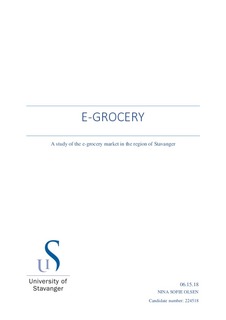A study of the e-grocery market in the region of Stavanger
Master thesis
Permanent lenke
http://hdl.handle.net/11250/2563956Utgivelsesdato
2018-06-15Metadata
Vis full innførselSamlinger
- Studentoppgaver (Business) [1035]
Sammendrag
The recent years there have been an increased interest in ordering groceries online because people prefer easier alternatives. For the companies, the only activities that are added for operating an online store compared to a traditional store are the processes required to pick, pack, and deliver the orders to the customers. There are many companies that have tried to survive in the e-grocery market, but unfortunately have failed since it has shown to be difficult to perform these operations efficiently and to obtain a proper number of customers. The unique thing about groceries compared to other products like clothes, interiors, furniture, etc. is that many types of groceries have temperature requirements, which makes the operations more difficult to perform compared to other firms operating online.
There exist many different models to offering grocery online. The models that will be investigated in this study is the attended home delivery, unattended home delivery, inside pick-up locations, and outside pick-up location, combined with either store-based picking model or warehouse-based picking model. The aim is to look at which model that will be the preferable regarding the long-run profit.
The results of the analysis showed that it is the store-based models that are the most profitable. These were more profitable than the warehouse-based models because the latter models have many additional costs that the store-based models do not have. Further, the company need many customers to make income, and therefore, the customers’ preferences are one of most essential factors when deciding which model to use. The two home delivery models, attended and unattended, will probably be the models the customers prefer because the customers will save more time using these models compared to do the shopping in the traditional way by going to a store themselves. Out of these two home delivery models the attended model will be the safest for the company to choose since the unattended model have higher costs associated to the delivery boxes. Thus, in the unattended model, the number of regular customers need to be higher than for the attended model in order for the income to exceed the costs. The e-grocery market in Norway have many fluctuations, and it will be risky for a company to do large investments in this market.
Beskrivelse
Master's thesis in Business Administration
